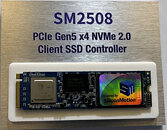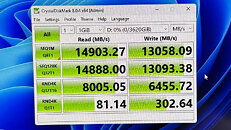TheLostSwede
News Editor
- Joined
- Nov 11, 2004
- Messages
- 17,771 (2.42/day)
- Location
- Sweden
| System Name | Overlord Mk MLI |
|---|---|
| Processor | AMD Ryzen 7 7800X3D |
| Motherboard | Gigabyte X670E Aorus Master |
| Cooling | Noctua NH-D15 SE with offsets |
| Memory | 32GB Team T-Create Expert DDR5 6000 MHz @ CL30-34-34-68 |
| Video Card(s) | Gainward GeForce RTX 4080 Phantom GS |
| Storage | 1TB Solidigm P44 Pro, 2 TB Corsair MP600 Pro, 2TB Kingston KC3000 |
| Display(s) | Acer XV272K LVbmiipruzx 4K@160Hz |
| Case | Fractal Design Torrent Compact |
| Audio Device(s) | Corsair Virtuoso SE |
| Power Supply | be quiet! Pure Power 12 M 850 W |
| Mouse | Logitech G502 Lightspeed |
| Keyboard | Corsair K70 Max |
| Software | Windows 10 Pro |
| Benchmark Scores | https://valid.x86.fr/yfsd9w |
Silicon Motion's SM2508 was first revealed in August last year at the Flash Memory Summit 2023, but after that things went pretty quiet. However, the company was demoing the SM2508 up and running at Computex this past week and it's set to edge out Phison's E26 Max14um in the battle of fastest NVMe SSD controller. We're not talking about any massive gains here, but the reference drive from Silicon Motion was shown running CrystalDiskMark 8.0.4 at the show and if we do a rough comparison to a Phison E26 Max14um, the SM2508 beats Phison by about 800 MB/s in sequential read performance and 500 MB/s in sequential write performance.
This might not seem like a whole lot, but the SM2508 is built on TSMC's N6 node which results in a 3.5 Watt peak power consumption, or 7 Watts for the entire SSD at load. A typical Phison E26 based SSD draws in excess of 11 Watts of power at full load, which is a big difference in a mobile device. This should obviously also lead to lower thermals and we should finally see PCIe 5.0 drives that don't need massive heatsinks or active cooling. In fact, 7 Watts power draw is very similar to Phison's E18 PCIe 4.0 based SSDs. Silicon Motion is still working on fine tuning the firmware for the SM2508, so performance might yet improve to reach the promised 14 GB/s write performance. Currently the random performance is also looking a bit on the weak side compared to Phison. According to Tom's hardware, we should see the first drives with the Silicon Motion SM2508 appear in the market sometime in Q4 this year.


View at TechPowerUp Main Site | Source
This might not seem like a whole lot, but the SM2508 is built on TSMC's N6 node which results in a 3.5 Watt peak power consumption, or 7 Watts for the entire SSD at load. A typical Phison E26 based SSD draws in excess of 11 Watts of power at full load, which is a big difference in a mobile device. This should obviously also lead to lower thermals and we should finally see PCIe 5.0 drives that don't need massive heatsinks or active cooling. In fact, 7 Watts power draw is very similar to Phison's E18 PCIe 4.0 based SSDs. Silicon Motion is still working on fine tuning the firmware for the SM2508, so performance might yet improve to reach the promised 14 GB/s write performance. Currently the random performance is also looking a bit on the weak side compared to Phison. According to Tom's hardware, we should see the first drives with the Silicon Motion SM2508 appear in the market sometime in Q4 this year.


View at TechPowerUp Main Site | Source









